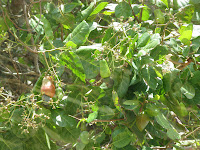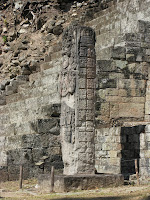Having left Guatemala city fairly early in the morning we drove towards Honduras, where we would be visiting the archeological site of Copan. We stopped quite a few times on the way to the border and as we approached it the landscape seemed to differ from the one we were leaving behind.


As we reached the border and were awaiting our passport stamping we saw some men approaching the incoming vehicles with huge amounts of money, until we realised the money exchange was being carried out there and then in the open.

We headed straight to the Archeoplogical park of Copan, once we crossed the border.
According to historians the first information about the ancient Maya city of Copan appeared around 1576 A.D. despite the fact that in the begining of the early classic period (400- 650 A.D.) it was the kingdom of the first eleven rulers. Having been declared declared patrimony of the Humanity in 1980 it is today the pride of the Hondurenan people.
Representations of the Monkey God from "Xibalba", the underworld.
Stela P erected around 623 A.D. portraying the ruler Kak'Uti Chan (Humo Serpiente).
Altar Q as seen from the west side with the founder of Copan dinasty Kinich Yax Kuk Mo translated as the Great Quetzal Macaw (on the left), passing a torch to the right central figure Yax Pahsaj Chan Yopat, the 16th and last ruler of Copan (left). Hieroglyph representation of the 16th ruler Yax Pahsaj on one of the upper doors of temple 11 (right).
Pieces which were removed from the buildings along the centuries, whose original places haven't yeat been found by the archeologists (left). Pauahtun, head of an old man located in the corner of temple 11 (right).
Jaguar Plaza, which is connected to the underworld. The left hand picture represents the sun and the right hand one the jaguar. This place may have witnessed many ceremonies so as to have the sun rise every morning after having escaped the darkness of the night.
Chak masks in the corners of temple 22.
(to be continued)






















No comments:
Post a Comment